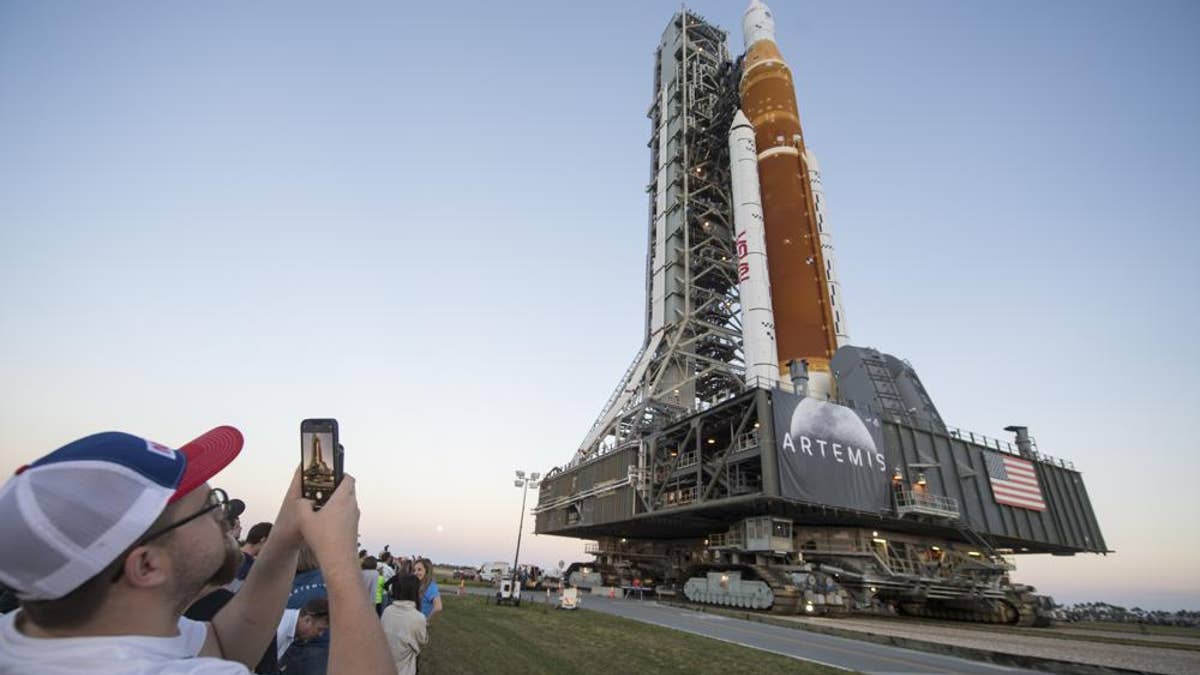On Wednesday, the 53rd anniversary of the Apollo 11 moon landing, NASA announced that it's targeting the end of August for the launch of its giant, new moon rocket.
NASA will attempt the more than month-long lunar test flight with three mannequins but no astronauts as early as Aug. 29. There are also two launch dates on Sept. 2 or Sept. 5.

Invited guests and NASA employees take photos as NASA's Space Launch System rocket with the Orion spacecraft aboard is rolled out of High Bay 3 of the Vehicle Assembly Building for the first time at the Kennedy Space Center in Cape Canaveral, Florida, on Thursday, March 17, 2022. (Aubrey Gemignani/NASA via AP, File)
"It's a special day, the anniversary of the Apollo 11 landing 53 years ago. It's really great to talk about this test flight to begin our Artemis program to go back to the moon," said NASA's James Free, associate administrator for Exploration Systems Development.
The much-anticipated flight will be the first launch of the agency’s massive Space Launch System rocket and NASA's continued campaign to return astronauts to the lunar surface for the first time since the last Apollo mission in 1972.
NASA, PARTNERS REVEAL STUNNINGLY-DETAILED FIRST IMAGES FROM JAMES WEBB SPACE TELESCOPE
The Artemis I mission will be the most ambitious test NASA has attempted since the 2014 EFT-1, a United Launch Alliance Delta IV Heavy rocket.
The 30-story Space Launch System rocket and attached Orion capsule are currently in the hangar at Kennedy Space Center, following repairs stemming from last month’s countdown test.

In this July 20, 1969, photo made available by NASA, astronaut Buzz Aldrin Jr. poses for a photograph beside the U.S. flag on the moon during the Apollo 11 mission. (Neil Armstrong/NASA via AP, File)
After arriving back inside the Vehicle Assembly Building at Kennedy Space Center on July 2 after last month's failed countdown test, the Space Launch System rocket and Orion capsule have undergone preparation work, including the replacement of seals and repair of a hydrogen leak.
FULL BUCK SUPERMOON CAPTURED AROUND GLOBE
NASA officials on Wednesday told reporters that the problems have been resolved and that testing is almost complete.
But they cautioned the launch dates could slip, depending on the volatile Florida weather and issues that might arise before the rocket is supposed to return to the pad on Aug. 18.
"We’re going to be careful," Free said.
At 322 feet (98 meters), the rocket and Orion capsule are taller than the Statue of Liberty.
A successful mission will poise the agency to fly astronauts around the moon in 2023 and attempt a lunar landing as soon as 2025.
Astronauts last explored the moon in 1972. The first of the 12 moon walkers, Neil Armstrong and Buzz Aldrin, stepped onto the dusty gray surface on July 20, 1969, while Michael Collins orbited the moon.
CLICK HERE TO GET THE FOX NEWS APP
The 92-year-old Aldrin, the sole survivor of the three, noted the anniversary in a tweet: "Neil, Michael & I were proud to represent America as we took those giant leaps for mankind. It was a moment which united the world and America’s finest hour."
The Associated Press contributed to this report.























